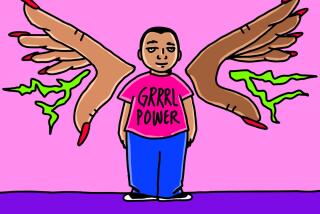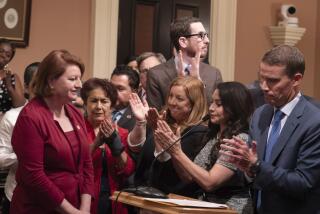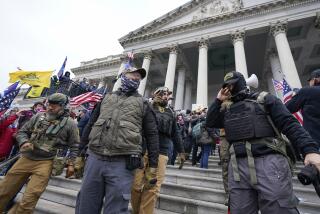Women were missing from school history lessons. An effort in California would change that
The year was 1972. In a high school classroom in Northern California, a student asked his teacher a timely question: What is the women’s movement?
Shirley Chisholm had just made history as the first African American to seek a presidential nomination from a major party. Title IX, the federal law that prohibits gender discrimination in education and sports, had passed, and Gloria Steinem and Dorothy Pitman Hughes had launched Ms. Magazine. Still, little information about the history of halfthe population was readily available to students.
For the record:
7:30 p.m. March 20, 2019A previous version of this article misstated the legal pseudonym attributed to Norma McCorvey in Roe vs. Wade. She was known in the case as Jane Roe.
Molly MacGregor, then a 24-year-old 11th-grade history teacher in Santa Rosa, came up nearly empty-handed in trying to answer her student’s question. The only item on women’s history she could find in her textbooks was a chapter about the Seneca Falls Convention, a women’s rights gathering in 1848.
The revelation that she knew — and could readily find — so little about the history that paved the way for her life of freedom was eye-opening.
“What I hadn’t absorbed was that, at the time, I was a married woman, teaching high school and wearing slacks to school,” MacGregor said. “What was most significant to me was that I had never asked my mother, who was dead at the time, about her own life.”
In a roundabout way, MacGregor’s experience in 1972 led to the creation of Women’s History Month, now celebrated across the U.S. each March.
A series of chance meetings between MacGregor and four other Sonoma County women sparked a shared mission to “write women back into history,” first by establishing a curriculum on the subject for schoolchildren, then by founding a nonprofit organization and finally by persuading the president of the United States to recognize the role of women every year.
“My whole life has been about promoting women,” she said.
The irony is that the work MacGregor and her four friends did rarely gets promoted. To the general public, their stories remain largely unknown.
In Santa Rosa, where MacGregor has lived for 45 years, many are unaware that she helped found Women’s History Month and inform her that it has started each March. Celebrity status, however, was never her goal.
We were starting from ground zero and we didn’t know it.
— Molly MacGregor
By 1974, MacGregor realized she needed to learn more about the contributions of women and enrolled as a graduate student at Sonoma State.
There, she met two other students, Paula Hammett and Bette Morgan. Hammett was working on a presentation about women’s history that was eventually shown in nursing homes, classrooms and union halls.
“We were trying to tell the stories that at that point very few people knew or remembered,” she said.
In 1977, MacGregor, Hammett and Morgan started working with the Education Task Force of the Sonoma County Commission on the Status of Women. That’s where the three of them met Mary Ruthsdotter and, together with input from others, developed Women’s History Week. The event was inspired by theme weeks, such as Ocean Week or Farm Week, that schools use to teach students about specific topics.
“We were starting from ground zero and we didn’t know it,” MacGregor said.
The women agreed their theme week should coincide with International Women’s Day on March 8, established in 1911 with roots dating to 1908. They worked on an accompanying curriculum for Sonoma County schools, pulling facts from UC Berkeley, which had a women’s history program, local libraries and the works of scholars including Gerda Lerner, a formidable figure who helped establish the field of women’s studies.
Their research also included an analysis of the lack of women in school textbooks. Eventually, the makers of those textbooks started asking for feedback.
“Harriet Tubman wasn’t even in them,” MacGregor said.
The women relied on an advisory board of female historians of color to ensure that their curriculum encompassed all of women’s history — not just that of white women.
“It was never a question,” said Hammett, who recently retired from Sonoma State.
With help from a federal grant though the Women’s Educational Equity Act, which funds the development of teaching materials free of gender bias, they expanded their mission.
By 1978 and 1979, Sonoma County Women’s History Week had grown from classrooms into a larger celebration, ending with a parade through downtown Santa Rosa. It was at a women’s symposium at Sarah Lawrence College in New York that MacGregor promoted what she and others were doing in California, earning support from attendees to create a National Women’s History Week.
After the symposium, the group formed a nonprofit organization in 1980 called the National Women’s History Project, now the National Women’s History Alliance. That same year, MacGregor received a call from the White House:
“This is a call for Molly MacGregor.”
The person speaking, MacGregor recalled, was Sarah Weddington, the attorney who years earlier had represented Norma McCorvey, “Jane Roe,” in the landmark U.S. Supreme Court case Roe vs. Wade. In 1980, she was a special assistant to President Carter.
Word about Women’s History Week in Sonoma County had made its way from the symposium to the White House. Weddington was calling on the president’s behalf to let MacGregor know he wanted to designate a week in March as Women’s History Week.
Carter signed a presidential proclamation, calling on Americans to recognize centuries of women’s history. “I urge libraries, schools, and community organizations to focus their observances on the leaders who struggled for equality — Susan B. Anthony, Sojourner Truth, Lucy Stone, Lucretia Mott, Elizabeth Cady Stanton, Harriet Tubman, and Alice Paul.”
One year later, first-term Sen. Orrin G. Hatch (R-Utah) and Rep. Barbara Mikulski (D-Md.) made Carter’s words a reality, introducing a resolution in Congress to officially designate Women’s History Week in March.
We were trying to tell the stories that at that point very few people knew or remembered.
— Paula Hammett
By 1986, 14 states had gone a step further and declared March as Women’s History Month. The momentum was used to lobby Congress to do the same nationally in 1987, leading thousands of schools across the country to use curricula to better inform students about the advances of women, with support from governors, city councils and school boards.
Today, a presidential proclamation issued every year declares March as Women’s History Month. It includes the names of five California women who made it happen — MacGregor, Hammett, Morgan, Ruthsdotter and musician Maria Cuevas, whom the four met along the way.
MacGregor and Hammett acknowledge society’s progress in the treatment and recognition of women. They spoke of the effects of the #MeToo movement and the women’s marches. A renewed women’s rights movement also has propelled a record number of women into politics.
But Hammett points to the ongoing challenges women face when it comes to protecting their access to birth control and healthcare more broadly.
“You know, we’ve been doing this for a long time,” she said. “I wish there could be a longer impact so we could move forward instead of fighting the same fights.”
Next year marks the 100th anniversary of women’s suffrage.
On Dec. 31, 2020, MacGregor will mark the year that women won the right to vote with a milestone of her own — retirement. She refers to her contributions as the product of the many women who came before her and is steadfast in her trust that the work to which she and others dedicated their lives will continue — with or without her.
The National Women’s History Alliance is honoring women at the end of the month in Washington, D.C. In Los Angeles, you can find women’s history events through the L.A. Conservancy and the L.A. Public Library.
More to Read
Start your day right
Sign up for Essential California for news, features and recommendations from the L.A. Times and beyond in your inbox six days a week.
You may occasionally receive promotional content from the Los Angeles Times.







